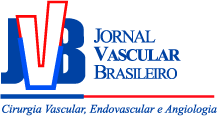Relação entre a mobilidade da articulação talocrural e a úlcera venosa
Relationship between talocrural joint mobility and venous ulcer
Cleusa Ema Quilici Belczak; Gildo Cavalheri Jr.; José Maria Pereira de Godoy; Roberto Augusto Caffaro; Sergio Quilici Belczak
Resumo
Palavras-chave
Abstract
Keywords
References
Welkie JF, Comerota AJ, Katz ML, Aldridge SC, Kerr RP, White JV. Hemodynamic deterioration in chronic venous disease. J Vasc Surg. 1992;16:733-40.
Barber RF, Shatara FI. The varicose disease. NY State J Med. 1925;31:574-80.
Pollack AA, Wood EH. The venous pressure in the saphenous vein at the ankle in man, during exercise and changes in posture. J Appl Physiol. 1949;1:649-62.
Nicolaides AN, Hussein MK, Szendro G, Christopoulos D, Vasdekis S, Clarke H. The relation of venous ulceration with ambulatory venous pressure measurements. J Vasc Surg. 1993;17:414-9.
Christopoulos D, Nicolaides AN, Cook A, Irvine A, Galloway JM, Wilkinson A. Pathogenesis of venous ulceration in relation to the calf muscle pump function. Surgery. 1989;106:829-35.
Araki CT, Back TL, Padberg FT. The significance of calf muscle pump function in venous ulceration. J Vasc Surg. 1994;20:872-7.
Back TL, Padberg FT Jr., Araki CT, Thompson PN, Hobson RW 2nd. Limited range of motion of the ankle joint is a significant factor in venous ulceration. J Vasc Surg. 1995;22:519-23.
Dix FP, Brooke R, McCollum CN. Venous disease is associated with an impaired range of ankle movement. Eur J Vasc Endovasc Surg. 2003;25:556-61.
Orsted HL, Radke L, Gorst R. The impact of musculoskeletal changes on the dynamics of the calf muscle pump. Ostomy Wound Manage. 2001;47:18-24.
Porter JM, Moneta GL. Reporting standards in venous disease: an update. International Consensus Committee on Chronic Venous Disease. J Vasc Surg. 1995;21:635-45.
Tinley P, Taranto M. Clinical and dynamic range of ankle motion techniques in subjects with and without diabetes mellitus. J Am Podiatr Med Assoc. 2002;92:136-42.
Somers DL, Hanson JA, Kedzierski CM, Nestor KL, Quinlivan KY. The influence of experience on the reliability of goniometric and visual measurement of forefoot position. J Orthop Sports Phys Ther. 1997;25:192-202.
Rosner B. Fundamentals of biostatistics. 1986.
Belczak Neto J, Belczak CEQ. A importância da goniometria do tornozelo na insuficiência venosa crônica dos membros inferiores. Tratado de flebologia e linfologia. 2006:459-68.
Loetzke HH. Über die Achlles-sehne mit ihren Faszienverhältnissen beim Menschen und den Subcutanvarizen im Bereich der Wadenmuskulatur. Anat Anz. 1956;103:287-304.
Kramer J, Gudat W. Der Talokrural-Winkel. Z Orthop Ihre Grenzgeb. 1980;118:855-8.
Schmeller W, Steidel G, Borgis KJ. Über den bewegungsumfang im oberen sprunggelenk bei venengesunden und venenkraken: ein beitrag zum arthrogenen staunngssyndrom. Phlebol Proktol. 1990;19:100-10.
Bolliger AA, Borgnis FE. Ein verbesserter Ultraschallströmungsmesser für intravasale Messungen. Mefmethoden in der Venenchirurgie. 1971:137-43.
Roaas A, Andersson GB. Normal range of motion of the hip, knee and ankle joints in male subjects, 30-40 years of age. Acta Orthop Scand. 1982;53:205-8.
Oppel U, Higushi F. Talokrural-Winkel und Sprunggelenksbeweglichkeit bei Deutschen und Japanern. Z Orthop. 1987;125:243-6.
Nigg BM, Fisher V, Allinger TL, Ronsky JR, Engsberg JR. Range of motion of the foot as a function of age. Foot Ankle. 1992;13:336-43.
Grimston SK, Nigg BM, Hanley DA, Engsberg JR. Differences in ankle joint complex range of motion as a function of age. Foot Ankle. 1993;14:215-22.
Wright AD. The treatment of indolent ulcer of the leg. Lancet. 1931;1:457-60.
Ruckley CV, Dale JJ, Callam MJ, Harper DR. Causes of chronic leg ulcer. Lancet. 1982;2:615-6.
Tierney S, Burke P, Fitzgerald P, O'Sullivan T, Grace P, Bouchier-Hayes D. Ankle fracture is associated with prolonged venous dysfunction. Br J Surg. 1993;80:36-8.
Timi JR, Futigami AY, Belczak SQ, Pradella FM. Ankle ankylosis and its importance in chronic venous disease. Int Angiol. 2005;24:148.
Browse NL, Burnand KG, Thomas ML. Síndrome da falência contrátil da panturrilha. Doenças venosas. 2001:433-60.
Kan YM, Delis KT. Hemodynamic effects of supervised calf muscle exercise in patients with venous leg ulceration: a prospective controlled study. Arch Surg. 2001;136:1364-9.
Yang D, Vandongen YK, Stacey MC. Effect of exercise on calf muscle pump function in patients with chronic venous disease. Br J Surg. 1999;86:338-41.
Belczak Neto J, Belczak CEQ. Reabilitação cinesiofisiátrica do flebopata crônico. Tratado de flebologia e linfologia. 2006:460-84.

